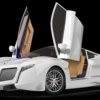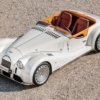### Rolls-Royce Specter The palette of the Goodwood company is literally a library of suicide doors. Even the luxury Cullinan SUV has them! We will use the Specter gran tourer as an example. Why him? First of all, because most of the cars in the review have rear “suicide” doors, while his has the front ones and the only ones. Their length, just for a minute, is one and a half meters – longer than any other Rolls-Royce! The silhouette is reminiscent of the Wraith coupe that the Spectrum replaced, but the detailing is quite unusual. For example, the main blocks of the head optics are darkened, and the sparkling “shield” simulating a radiator grille is very wide.
Rolls-RoyceThis time the “grill” has only a decorative function, because the Specter is an all-wheel drive electric car. Together, the engines develop 584 hp. and 900 Nm. Acceleration to 100 km/h in 4.5 seconds.
Rolls-Royce ### HiPhi X Suicide doors are a chic addition to the mind-blowing Chinese electric cars. I just want to ask: “What planet did you come from, gentlemen?!” Please note that the X, a hefty 5.2-meter-long crossover/minivan hybrid, has rear doors with lift-up sections in the roof. The spectacular solution is designed to make boarding and disembarking very convenient and, in addition, with elements of a show. All six doors (in fact, there are exactly that many) are controlled by separate modules and opened by pressing a special button.
### HiPhi X Suicide doors are a chic addition to the mind-blowing Chinese electric cars. I just want to ask: “What planet did you come from, gentlemen?!” Please note that the X, a hefty 5.2-meter-long crossover/minivan hybrid, has rear doors with lift-up sections in the roof. The spectacular solution is designed to make boarding and disembarking very convenient and, in addition, with elements of a show. All six doors (in fact, there are exactly that many) are controlled by separate modules and opened by pressing a special button.
HiPhi X is interesting without regard to the design “obscurantism” in the best sense of the word. It comes with a rear-mounted 299-horsepower electric motor or all-wheel drive with a combined output of 598 hp. The maximum speed of both versions is limited to 200 km/h. The top model reaches a hundred in 3.9 seconds. High-tech in X is ubiquitous: a third-level autopilot, matrix optics with light indication and programming capabilities, a Human Oriented Architecture (HOA) software and hardware platform with six domain controllers and 500 sensors, and also supporting the 5G-V2X standard.
X is interesting without regard to the design “obscurantism” in the best sense of the word. It comes with a rear-mounted 299-horsepower electric motor or all-wheel drive with a combined output of 598 hp. The maximum speed of both versions is limited to 200 km/h. The top model reaches a hundred in 3.9 seconds. High-tech in X is ubiquitous: a third-level autopilot, matrix optics with light indication and programming capabilities, a Human Oriented Architecture (HOA) software and hardware platform with six domain controllers and 500 sensors, and also supporting the 5G-V2X standard.
HiPhi ### HiPhi Z This Martian suicide vehicle has classic-looking doors without “wings” in the roof. However, even without them the appearance is slightly shocking – such a design is worthy of being considered sensational. The only all-wheel drive modification is equipped with a traction battery with a capacity of 90 or 120 kWh (HiPhi X has 97 kWh). Output is 672 hp, but the advantage over the top-end X is only 0.1 second.
### HiPhi Z This Martian suicide vehicle has classic-looking doors without “wings” in the roof. However, even without them the appearance is slightly shocking – such a design is worthy of being considered sensational. The only all-wheel drive modification is equipped with a traction battery with a capacity of 90 or 120 kWh (HiPhi X has 97 kWh). Output is 672 hp, but the advantage over the top-end X is only 0.1 second.
HiPhi To finally “finish off” the audience, HiPhi used Star-Ring ISD “light curtain” technology with 4066 LEDs throughout the body. With their help, the grand tourer “communicates” with the outside world. There are other advantages besides aesthetics and temperament. For example, air suspension with electronically controlled shock absorbers and rear axle steering (the wheels deflect by an impressive 13.2 degrees, making the Z maneuverable like a small hatchback), autopilot, ambient lighting with stereoscopic effect, a Meridian sound system with 23 speakers and two levels of output power.
To finally “finish off” the audience, HiPhi used Star-Ring ISD “light curtain” technology with 4066 LEDs throughout the body. With their help, the grand tourer “communicates” with the outside world. There are other advantages besides aesthetics and temperament. For example, air suspension with electronically controlled shock absorbers and rear axle steering (the wheels deflect by an impressive 13.2 degrees, making the Z maneuverable like a small hatchback), autopilot, ambient lighting with stereoscopic effect, a Meridian sound system with 23 speakers and two levels of output power.
HiPhi ### Ferrari Purosangue In the premium crossover segment, “suicide doors” until recently were the prerogative of the super exclusive. The pattern was broken by… No, not just any Mercedes-Maybach, but a Ferrari. The unusual element was made into a feature of the extreme SUV Purosangue with a body made of aluminum and carbon fiber. The manufacturer tried to get rid of any negative associations and calls such doors nothing more than “welcome doors”. They swing open electrically to an angle of 79 degrees. For comparison, the value at the front is 63 degrees.
### Ferrari Purosangue In the premium crossover segment, “suicide doors” until recently were the prerogative of the super exclusive. The pattern was broken by… No, not just any Mercedes-Maybach, but a Ferrari. The unusual element was made into a feature of the extreme SUV Purosangue with a body made of aluminum and carbon fiber. The manufacturer tried to get rid of any negative associations and calls such doors nothing more than “welcome doors”. They swing open electrically to an angle of 79 degrees. For comparison, the value at the front is 63 degrees.
Ferrari Formally, Purosangue is a SUV, but with a very non-trivial styling. From a design point of view, it also overturns conventional ideas. The lion’s share of competitors, including the Lamborghini Urus, are armed with four-liter twin-turbo eights, but the bright engineering minds from Ferrari did not stoop to such “platitudes” – under the hood is a 6.5-liter naturally aspirated V12 (725 hp and 716 Nm) with a dry sump . A completely unique solution by the standards of the segment!
Formally, Purosangue is a SUV, but with a very non-trivial styling. From a design point of view, it also overturns conventional ideas. The lion’s share of competitors, including the Lamborghini Urus, are armed with four-liter twin-turbo eights, but the bright engineering minds from Ferrari did not stoop to such “platitudes” – under the hood is a 6.5-liter naturally aspirated V12 (725 hp and 716 Nm) with a dry sump . A completely unique solution by the standards of the segment!
Ferrari ### Fiat 500 3+1 In the range of the small “five hundred” there is a rather interesting modification with a short “gate” behind on the starboard side to facilitate entry and exit. At the same time, it is no larger than a standard hatchback, and the passenger door is of standard length. Please note: the suicide door does not have an external handle, so it will not be possible to open it from the outside when the main door is closed.
### Fiat 500 3+1 In the range of the small “five hundred” there is a rather interesting modification with a short “gate” behind on the starboard side to facilitate entry and exit. At the same time, it is no larger than a standard hatchback, and the passenger door is of standard length. Please note: the suicide door does not have an external handle, so it will not be possible to open it from the outside when the main door is closed.
Fiat “Three plus one” is loyal to nature and the urban environment: it is driven by an electric motor (118 hp and 220 Nm). Autonomy in the city according to the WLTP cycle is up to 460 kilometers. Acceleration to 100 km/h takes nine seconds, the limit is 150 km/h.
“Three plus one” is loyal to nature and the urban environment: it is driven by an electric motor (118 hp and 220 Nm). Autonomy in the city according to the WLTP cycle is up to 460 kilometers. Acceleration to 100 km/h takes nine seconds, the limit is 150 km/h.
Fiat ### Citroen Ami Rear “vest” doors are an interesting design technique for city kids. But Citroen’s individual worldview and views on how to design cars did not allow them to act “like everyone else.” The Ami microcar is a cool example of how to gracefully play with symmetry and asymmetry to make everyone gasp. Not only are the front and rear facings almost identical, but the doors also open in different directions. Driver’s – against the direction of travel. French, what can I say…
### Citroen Ami Rear “vest” doors are an interesting design technique for city kids. But Citroen’s individual worldview and views on how to design cars did not allow them to act “like everyone else.” The Ami microcar is a cool example of how to gracefully play with symmetry and asymmetry to make everyone gasp. Not only are the front and rear facings almost identical, but the doors also open in different directions. Driver’s – against the direction of travel. French, what can I say…
Citroen “Ami” is so small that against its background Japanese kei cars (urban superminis up to 3.4 meters long) will seem like giants. Between the flat bumpers there are microscopic 2410 mm, width 1390 mm. A toy, and nothing more! The electric power plant matches its dimensions: the electric motor produces a ridiculous 6 kW (8.2 hp), the capacity of the traction battery is 5.4 kWh. Cruising range is 75 kilometers, maximum speed with tailwind is 45 km/h. By the way, Ami dials it in ten seconds.
“Ami” is so small that against its background Japanese kei cars (urban superminis up to 3.4 meters long) will seem like giants. Between the flat bumpers there are microscopic 2410 mm, width 1390 mm. A toy, and nothing more! The electric power plant matches its dimensions: the electric motor produces a ridiculous 6 kW (8.2 hp), the capacity of the traction battery is 5.4 kWh. Cruising range is 75 kilometers, maximum speed with tailwind is 45 km/h. By the way, Ami dials it in ten seconds.
Citroen ### BMW i3 The “electric” nature of the small hatchback gave its creators carte blanche for any artistic experiments (remember, Richard Kim was responsible for the styling of the i-3, as in the case of the sports BMW i8). The rear suicide doors were the icing on the cake. Without them, the image would be simpler and more banal.
### BMW i3 The “electric” nature of the small hatchback gave its creators carte blanche for any artistic experiments (remember, Richard Kim was responsible for the styling of the i-3, as in the case of the sports BMW i8). The rear suicide doors were the icing on the cake. Without them, the image would be simpler and more banal.
BMW The small Bimmer comes standard with a 170 hp electric motor driving the rear wheels. “Hot” i3s (pictured) – 184 horsepower.
The small Bimmer comes standard with a 170 hp electric motor driving the rear wheels. “Hot” i3s (pictured) – 184 horsepower.
BMW ### Mazda MX-30 It would seem that consumers have seen every possible design exercise on the subject of subcompact crossovers. And the artsy Nissan Juke, and the aggressive Toyota C-HR, and many other cars. But Mazda still surprised: it turned out that the cross-coupe could be created according to other recipes. The body panels are devoid of “visual noise”, the rear part has a pronounced slope, and there are small suicide doors behind the front doors. Grace in just a few strokes!
### Mazda MX-30 It would seem that consumers have seen every possible design exercise on the subject of subcompact crossovers. And the artsy Nissan Juke, and the aggressive Toyota C-HR, and many other cars. But Mazda still surprised: it turned out that the cross-coupe could be created according to other recipes. The body panels are devoid of “visual noise”, the rear part has a pronounced slope, and there are small suicide doors behind the front doors. Grace in just a few strokes!
Mazda The MX-30 is original not only for its exterior. All options have electrification. For example, in a completely environmentally friendly crossover, the front wheels are driven by a 145-horsepower engine. Mazda MX-30 R-EV causes heart palpitations among admirers of the brand’s traditions of rotary piston engines. The power plant includes a compact RPD. Alas, it is not connected to the wheels, but only drives the generator to recharge the traction battery. The electric motor installed on the R-EV has a power of 170 hp.
The MX-30 is original not only for its exterior. All options have electrification. For example, in a completely environmentally friendly crossover, the front wheels are driven by a 145-horsepower engine. Mazda MX-30 R-EV causes heart palpitations among admirers of the brand’s traditions of rotary piston engines. The power plant includes a compact RPD. Alas, it is not connected to the wheels, but only drives the generator to recharge the traction battery. The electric motor installed on the R-EV has a power of 170 hp.
Mazda ### Mazda RX-8 At the beginning of the 2000s, the Hiroshima brand quite excited the automotive community with its mischievous driver’s philosophy of Zoom-Zoom. Its crowning achievement was the RX-8 sports coupe. It didn’t have the power of the previous RX-7 with a 1.3-liter turbocharger RPD, but it won hearts with its classy handling and striking image. For the sake of greater practicality, the “Ryxa” used rear suicide doors without B-pillars: it was conceived as a full-fledged four-seater, and not with a 2+2 seating arrangement, where the rear passengers, no, no, but feel deprived.
### Mazda RX-8 At the beginning of the 2000s, the Hiroshima brand quite excited the automotive community with its mischievous driver’s philosophy of Zoom-Zoom. Its crowning achievement was the RX-8 sports coupe. It didn’t have the power of the previous RX-7 with a 1.3-liter turbocharger RPD, but it won hearts with its classy handling and striking image. For the sake of greater practicality, the “Ryxa” used rear suicide doors without B-pillars: it was conceived as a full-fledged four-seater, and not with a 2+2 seating arrangement, where the rear passengers, no, no, but feel deprived.
Mazda The 1.3-liter Renesis rotary unit did not have a supercharging system and developed, at best, 241 hp. But the weight distribution is close to ideal, so you won’t get bored with the RX-8. Production continued for more than nine years and ended in 2012.
The 1.3-liter Renesis rotary unit did not have a supercharging system and developed, at best, 241 hp. But the weight distribution is close to ideal, so you won’t get bored with the RX-8. Production continued for more than nine years and ended in 2012.
Mazda ### Saturn Ion Quad Coupe The long-defunct General Motors coupe debuted at the 2002 New York Motor Show and was clearly influenced by the Mazda RX-8 show car that eventually became the production car. Here the principle is the same: rear “vests” and the absence of central pillars. The length is noticeably longer than that of the Japanese sports car, and the wheelbase is shorter: 2621 mm versus 2703 mm. Hence the huge overhangs.
### Saturn Ion Quad Coupe The long-defunct General Motors coupe debuted at the 2002 New York Motor Show and was clearly influenced by the Mazda RX-8 show car that eventually became the production car. Here the principle is the same: rear “vests” and the absence of central pillars. The length is noticeably longer than that of the Japanese sports car, and the wheelbase is shorter: 2621 mm versus 2703 mm. Hence the huge overhangs.
General Motors The regular Ion Quad Coupe was equipped with naturally aspirated “fours” with a volume of 2.2 and 2.4 liters. Those who like it hotter were offered the Red Line Edition (model years 2004–2007, pictured) with a 2.0-liter compressor engine producing 208 hp. If its potential was not enough, the Competition Package was used (a limited-slip differential, 17-inch wheels of a special design and other upgrades) and several levels of boost. The maximum Stage 2 made it possible to squeeze out 245 hp.
The regular Ion Quad Coupe was equipped with naturally aspirated “fours” with a volume of 2.2 and 2.4 liters. Those who like it hotter were offered the Red Line Edition (model years 2004–2007, pictured) with a 2.0-liter compressor engine producing 208 hp. If its potential was not enough, the Competition Package was used (a limited-slip differential, 17-inch wheels of a special design and other upgrades) and several levels of boost. The maximum Stage 2 made it possible to squeeze out 245 hp.
General Motors ### Honda Element As you already understand, suicide doors are often used not only for style, but also for practicality. And what could be more functional than the Honda Element “box”? The organization of its interior space is amazing: how does such a compact car manage to be so spacious and well thought out?! When you open the front and rear doors, you get an opening 1.4 meters wide. In the absence of central pillars, the rigidity of the power structure is achieved by strengthening the thresholds, floor and roof.
### Honda Element As you already understand, suicide doors are often used not only for style, but also for practicality. And what could be more functional than the Honda Element “box”? The organization of its interior space is amazing: how does such a compact car manage to be so spacious and well thought out?! When you open the front and rear doors, you get an opening 1.4 meters wide. In the absence of central pillars, the rigidity of the power structure is achieved by strengthening the thresholds, floor and roof.
Honda The optional all-wheel drive is simple – with a traction take-off clutch on the rear axle. The engines, according to the then Honda tradition, are naturally aspirated with a volume of 2.4 liters with an i-VTEC variable valve timing system.
The optional all-wheel drive is simple – with a traction take-off clutch on the rear axle. The engines, according to the then Honda tradition, are naturally aspirated with a volume of 2.4 liters with an i-VTEC variable valve timing system.
Honda ### Toyota FJ Cruiser “Suicide doors” are a common story on cab-and-a-half pickups and a rarity on SUVs. I immediately remember the charismatic Toyota FJ Cruiser, which lasted on the assembly line from the beginning of 2006 until the end of 2022. It is styled after the legendary Kruzak J40 and shares a frame platform with the North American 4Runner and Land Cruiser Prado of the previous generation. The engine is the same as the donors – a four-liter V6.
### Toyota FJ Cruiser “Suicide doors” are a common story on cab-and-a-half pickups and a rarity on SUVs. I immediately remember the charismatic Toyota FJ Cruiser, which lasted on the assembly line from the beginning of 2006 until the end of 2022. It is styled after the legendary Kruzak J40 and shares a frame platform with the North American 4Runner and Land Cruiser Prado of the previous generation. The engine is the same as the donors – a four-liter V6.
Toyota All-terrain vehicles with two doors on each side have long gone out of fashion, with the exception of such timeless classics as the Jeep Wrangler, Suzuki Jimny and their ilk, as well as newcomers like the Ford Bronco and the modern Land Rover Defender. But the FJ Cruiser is of a slightly different format: with rear suicide doors, which greatly facilitate access to the interior of a fairly tall car and provide convenient exit.
All-terrain vehicles with two doors on each side have long gone out of fashion, with the exception of such timeless classics as the Jeep Wrangler, Suzuki Jimny and their ilk, as well as newcomers like the Ford Bronco and the modern Land Rover Defender. But the FJ Cruiser is of a slightly different format: with rear suicide doors, which greatly facilitate access to the interior of a fairly tall car and provide convenient exit.
Toyota
Reverse-opening doors were the norm until World War II and then gradually became the preserve of sedans. Now suicide doors are mainly associated with the Royal Rolls-Royce couple, but of course the matter is not limited to that. We decided to recall some production cars from the present and recent past with “suicide doors”. You will definitely be surprised at their variety and quantity!







